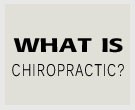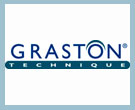Graston Technique®
Graston Technique® Instrument-assisted Soft Tissue Mobilization (GISTM) is an advanced form of soft tissue mobilization that is used to detect and release scar tissue, adhesions and fascial restrictions.
Conditions which have responded particularly well to the Graston Technique® include:
- Medial/lateral epicondylitis
- Carpal Tunnel Syndrome
- Plantar Fasciitis
- Shin Splints
- Rotator Cuff Syndrome
- IT Band Syndrome
- Tendinitis/Tendinosis
- Heel Pain
- Myofascial Pain and Restrictions
- Chronic and Acute Sprains/Strains
- Non-acute Bursitis
- Achilles Tendinitis
- Reduced Range of Motion due to Scar Tissue
- Post-surgical and Traumatic Scars
- Neck and Back Pain
- Hamstring Syndrome
Flash animated slide show about the benefits of the Graston Technique®:
For more information, please see www.GrastonTechnique.com
Graston Case Studies:
CASE STUDY: Graston Technique® Proves Effective on Patient with Plantar Facsciitis
By Shelia Wilson, DC., CCSP, ICSSD
In 1996, a 30-year-old female presented with severe pain in both feet. Her physician prescribed physical therapy where she was told she had flat feet with no arch. After several months of therapy, the patient noticed minimal pain difference so treatment was discontinued. A year later the pain had worsened and the patient went to a podiatrist who made inserts for her shoes and advised her to purchase different shoes. The pain continued and by 2002, the patient was barely able to put any pressure on her feet. She consulted an orthopedic surgeon, who performed a series of X-Rays and other testing, which led to advising the patient her only option was to reconstruct her feet through surgery. The surgery would include building an arch and stretching her Achilles tendon, and would require her to be in a wheel chair for eight weeks.
As a last resort, the patient decided to consult our office because we had previously treated her for lower back and knee pain with good results. By this time, the patient was unable to run or workout and described the pain as immediate burning and cramping when she walked or tried to jog. The pain was severe in the morning and required stretching and massage before she was able to get out of bed.
Upon evaluation, it was noted the patient had extreme bilateral pes planus and over pronation. Plantar fascia and Achilles tendon were taut bilaterally, and pressure over the plantar fascia was described as painful. Pain was only noted in the plantar aspect of the foot with dorsiflexion. There was no Achilles or calf pain.
Treatment The patient was treated with Graston Technique®. Using GT4, the plantar surface of the foot was scanned and treated for 3-4 minutes. Then GT3 was used along the medial aspect of the arch and plantar fascia and the lower portion of the Achilles tendon attachment. The foot was then stretched, and the same treatment was repeated on the other foot.
Result After the first treatment, the patient stood up and noted an immediate difference in the level of pain. She put on her shoes, walked around and reported surprise and relief. She was advised on further stretching to do at home and scheduled for a follow-up treatment. After the third treatment, the patient began to exercise, and has regained the ability to exercise five days a week with unlimited walking.
Disclaimer: The preceding is to provide information about benefits that may be derived. It is not intended to claim a cure for any disease or condition. It should not take the place of medical advice or treatment.
CASE STUDY: Graston Technique® (GT) Yields Immediate Results for Long Distance Runners
By Thomas E. Hyde, DC, DACBSP
Several long distance runners complained of lower back pain during their runs for various periods of time ranging from several weeks to months. Conservative care which consisted of self-exercise, stretching, heat, ice and manipulation had failed to reduce the pain that prevented peak performance. Upon examination of the three runners, all exhibited excellent ROM of the thoracolumbar spine and excellent flexibility of the hamstrings.
Pain to palpation was present over the SI joints bilaterally with all other orthopedic and neurological testing within normal limits. The athletes were asked to assume a position that would recreate the pain. One of the runners stated that the pain began after running for a short period of time and was asked to run and return immediately following the onset of pain. The remaining two runners were treated in the provocative position to relax and then resume the position of pain production. During this procedure of placing them into positions of provocation, the exact location of pain would move from a few millimeters to completely new areas. Treatment was performed in each of the positions and ultimately presented in all three runners in the abdomen once the lower back pain had been eliminated.
The runner who had been asked to run and return when the pain began was treated in the same manner described above. The last area treated was the abdomen in all three runners.
Instruments GT 4, GT 6, and GT 3 were used to treat the lower lumbar region, SI joints bilaterally and the abdomen. Pain was eliminated in all three runners as a result of GT. Each of the runners provided a follow-up several months later and remarked that the pain never returned.
Disclaimer: The preceding is to provide information about benefits that may be derived. It is not intended to claim a cure for any disease or condition. It should not take the place of medical advice or treatment.
CASE STUDY: Graston Technique® (GT) – Effective Treatment for Debilitating Foot Pain
By David Folweiler, DC, Folweiler Chiropractic, Seattle, WA
A 17- year- old dancer, who was accustomed to dancing 3-4 hours per day, 5-6 days per week, participated in a 24-hour dance marathon fundraiser on a concrete floor. As a result, she had severe pain occurring in the ball of her foot only when engaged in weightbearing activity.
X-rays and M/R are negative, except for fluid on the ankle. Her physical therapy, consisting primarily of massage did not improve her condition. She ceased dancing for over a month with no effect on the condition. Her orthopedic recommended GT.
Her foot is supple, and has a decent longitudinal arch. Mobilization of the second and third metatarsal heads seems more restricted on the affected side. Palpation does not recreate the complaint; it is tender, but not painful. The complaint is recreated with weightbearing or strong passive dorsiflexion with knee and hip flexion.
After two aggressive treatments focusing on the plantar and dorsal regions of the foot, and in the posterior leg with isometric contraction, there was no noticeable change in her symptoms.
I treated her a total of nine times, focusing mostly on the tissues between the second and third metatarsal heads. Her condition completely resolved and she’s returned to her full dancing schedule. She was pleased with the outcome.
Disclaimer: The preceding is to provide information about benefits that may be derived. It is not intended to claim a cure for any disease or condition. It should not take the place of medical advice or treatment.
CASE STUDY: The conservative treatment of Trigger Thumb using Graston Technique® and Active Release Technique®
By Scott Howitt DC, FCCSS(C), FCCRS(C)*, Jerome Wong DC, Sonja Zabukovec DC This is an excerpt from an article published in the 2006 Journal of Canadian Chiropractic Association.
This case report involves a male 42-yearold subject who had a clinical diagnosis and diagnostic ultrasound verification of trigger finger. The patient was a walk-in patient at a multidisciplinary sports medicine clinic. The subject presented with a moderately painful right thumb with restricted motion, exhibiting an inability to actively flex and extend the right thumb, passive motions consistently produced pain and clicking. Palpation of the A1 pulley and joint play of the distal interphalangeal joint reproduced and exacerbated the reported pain. Palpable adhesions were noted in the flexor pollicis longus tendon of his right thumb.
The subject reported he could previously extend the thumb all the way back to his forearm. The onset was gradual over the previous week and he did not experience any other symptoms, illnesses or comorbidities that could be associated with trigger finger. A previous diagnosis of trigger thumb was suggested by his sports medicine physician who suggested a corticosteroid injection. The diagnostic ultrasound report revealed a severe tenosynovitis involving the flexor pollicis longus of the right thumb, and a prominent thickening of the A1 pulley of the thumb measuring approximately 5mm.
Upon real-time evaluation, the technologist noted triggering in keeping with a trigger finger. Bony proliferative changes were seen within the subjacent distal interphalangeal joint, however no cystic or solid mass was seen in this area. The left side was normal in comparison. Clearly, the diagnostic imaging impressions were consistent with a trigger thumb on the right side.
Treatment The patient was treated with Graston Technique® (GT) and Active Release Technique® (ART) by a certified provider, followed by ice post-treatment. In addition the patient was advised to self-mobilize the thenar eminence and first digit.
Results of Treatment There were 8 treatment sessions that were performed on the subject over a 4-week time period. After the first treatment involving Active Release Technique® and Graston Technique®, the subject had increased range of motion (ROM), however moderate pain was still present at end range. Specifically, there was no clicking with flexion or extension and the extension of the thumb was restored to full range. After the third treatment, there was minimal pain upon palpation and the ROM was full without pain. The patient reported to be utilizing his stick shift handle in his car to help self mobilize. By the sixth treatment, there was full pain free ROM and only minimal pain at the capsule with deep palpation, although some weakness/fatigue was becoming evident with repeated flexion. Flexor pollicis longus was rated a 4/5 (patient could hold the position against strong to moderate resistance with full range of motion). At this point the subject reported that he was able to perform all activities of daily living.
At the seventh treatment, ROM remained full with no recurrence of pain, snapping, or clicking. There was still some mild residual pain at the right capsule of the interphalangeal joint but less than previous. By the eighth treatment, there was no pain and only slight irritation at the capsule in full flexion when forced. There was mild weakness (4/5) present as noted in the previous visit but no palpable adhesions were present. The patient had full normal range of motion restored in the right thumb with no pain.
The subject was given “theraputty” and released with thumb exercises (flexion, extension, abduction and adduction) to continue on with strengthening at home. Two months after discharge and 14 months after discharge, he was contacted by telephone and he reported no reaggravations or further complications, with complete resolution and increased strength to pre-injury status.
Conclusion Trigger Thumb is a condition characterized by fibrocartilagenous metaplasia and hypertrophy of the surrounding structures of the flexor tendon resulting in a painful and debilitating restriction of motion. The causes of this flexor tendinopathy are believed to be multi-factorial including anatomical variations of the pulley system and biomechanical etiologies including exposure to shear forces and unaccustomed activity. Conventional treatment aims at decreasing inflammation through corticosteroid injection or surgically removing imposing tissue.
Both of these alternatives are invasive, and current research reveals that inflammation may not be a significant factor in the development of this condition. Adhesions and nodules can be evaluated clinically at several locations along the flexor tendon and confirmed with diagnostic ultrasound. In this case, a patient with trigger thumb appeared to be relieved of his pain and disability with increased range of motion after having eight treatments of ART and GT. As a result, a prospective study to investigate these soft tissue mobilization techniques is warranted.
Disclaimer: The preceding is to provide information about benefits that may be derived. It is not intended to claim a cure for any disease or condition. It should not take the place of medical advice or treatment.






